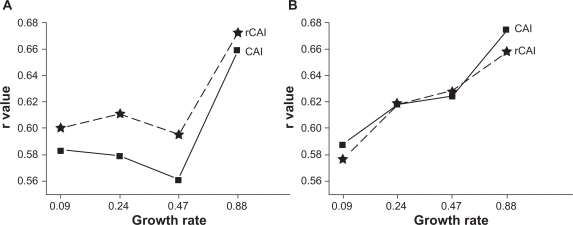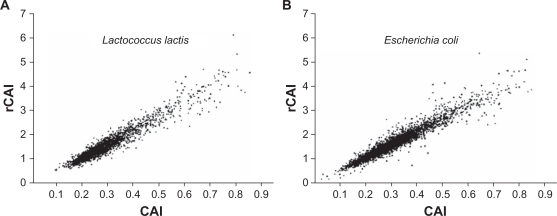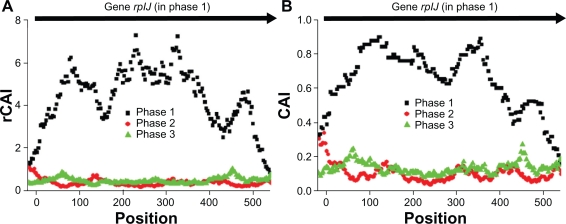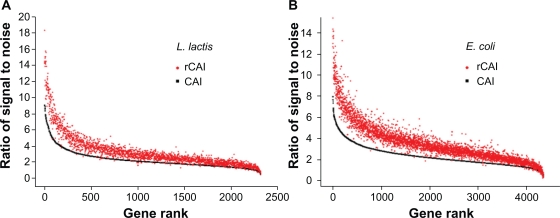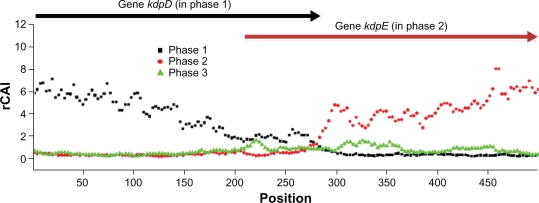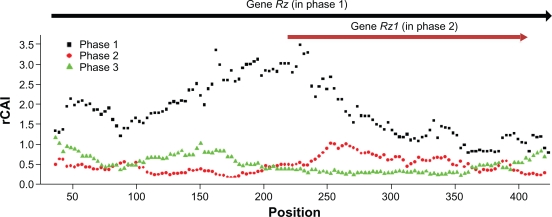Abstract
We propose a simple, sensitive measure of synonymous codon usage bias, the Relative Codon Adaptation Index (rCAI), as a way to discriminate better between highly biased and unbiased regions, compared with the widely used Codon Adaptation Index (CAI). CAI is a geometric mean of the relative usage of codons in a gene, and is calculated using the codon usage table trained with a set of highly expressed genes. In contrast, rCAI is computed by subtracting the background codon usage trained with two noncoding frames of highly expressed genes from the codon usage in the coding frame. rCAI has higher signal-to-noise ratio than CAI, considering that noncoding frames would not show codon bias. Translation efficiency and protein abundance correlates comparably or better with rCAI than CAI or other measures such as ‘effective number of codons’ and ‘SCUMBLE offsets’. Within overlapping coding regions, one of the two coding frames dominates in codon usage bias according to rCAI. Presumably, rCAI could substitute CAI in diverse applications.
Keywords: codon usage bias, codon adaptation index, translation efficiency, overlapping genes
Introduction
It has long been known that synonymous codons are used with unequal frequencies in many organisms.1 Such bias can be explained by several possible causes: heterogeneity of nucleotide base composition,2 asymmetric mutation rates in the leading and lagging strands of DNA replication,3,4 transcription effectiveness,5,6 protein hydropathy,7 and selection pressure for optimizing translational efficiency.8 Although the major source of bias differs from species to species, the phenomenon of codon usage bias is universal across diverse taxa.9–13 Codon usage bias is considered important in the study of molecular evolution14 and expression of exogenous protein.15,16
Since Ikemura proposed a measure of codon usage bias, ‘frequency of optimal codons’ (fop), associated with tRNA abundance,17 a vast number of different codon bias measures18–25 have been developed, indicating the biological relevance of codon bias. Among them, ‘codon adaptation index’ (CAI)18 is one of the most widely used. CAI was originally proposed to provide a normalized estimate that can be used across genes and species, ranging from 0 to 1. The boundary values refer to the cases in which only the most frequent codons (CAI = 1) or only the least frequent codons (CAI = 0) are used within a gene.
CAI has been used as a simple and effective measure of the overall synonymous codon usage bias of a gene. Highly expressed genes, including ribosomal proteins and transcription and translation factors, tend to have high CAI.26,27 CAI has been used extensively in diverse biological research: for measuring translation efficiency and predicting cellular protein levels,28,29 for verifying high-throughput expression quantification techniques30,31 and for optimizing DNA vaccines.32
CAI of a gene is computed as the geometric mean of the relative adaptiveness (w) of all the codons in the gene.18 The relative adaptiveness wj for codon of kind j that codes for amino acid i is defined as below:
where Xij is the number of occurrences of codon j in the reference set of highly expressed genes and Ximax is the maximum Xij for amino acid i. Practically in computer calculation, CAI is computed as follows:
where L is the number of codons in the gene and wc(k) is the w value for the k-th codon in the gene.
Intragenic variation of synonymous codon usage bias has been documented.33 Some software programs provide an option of displaying local CAI values along a gene.34,35 However, we observe that local CAI values are relatively noisy and that CAI still has a room for improvement in close examination of short regions. Motivated by this limitation, we propose a modified version of CAI that can apparently capture local signals more sensitively and produce less noise when applied to regions expecting little or no codon bias.
Algorithms and Datasets
Relative CAI
The ‘relative codon adaptation index’ (rCAI) is calculated from the LNWD table, which is defined as below:
for codon of kind i, where w1,i is identical to wi defined in the original CAI paper.18 w2,i and w3,i are equivalent to w1,i, except that they are trained from the phases +1 and +2 of the identical reference set composed of highly expressed genes.
rCAI is computed as below:
where L is the number of codons in the gene and LNWDc(k) is the LNWD value for the k-th codon in the gene. Based on our notation, CAI can be expressed as:
Compiling protein coding sequences
In this study, we restricted our scope within prokaryotes. Genomic sequences (.fna) and gene locations (.gff) obtained from the NCBI ftp site were used to extract protein coding sequences for Escherichia coli K12 M1655 (NC_000913) and Lactococcus lactis ssp. lactis IL1403 (NC_002662). A set of highly expressed genes predicted iteratively by Ramazzotti et al34 were used to train the LNWD table for each of the two species mentioned above. We first checked that the positions listed in their results matched with the coding positions we compiled from the .gff files and used the corresponding extracted sequences to compute lnw and LNWD. The same reference set was used in calculation of rCAI and CAI for comparison.
Translation efficiency and protein abundance
Dressaire et al quantified absolute protein abundance based on the APEX method30 along with mRNA abundance in L. lactis, under four different growth conditions. 31 Translation efficiencies could be approximated by dividing protein abundance by mRNA abundance, although they would be compounded by differential protein degradation. Using these data sets, we were able to obtain translation efficiencies for 171 L. lactis genes.
For E. coli genes, the APEX-based protein profiling data were provided by Lu et al30 but the mRNA abundance levels were not. Thus, translation efficiency data could not be obtained for E. coli genes.
Correlation analysis
For testing correlation between rCAI and CAI, all genes annotated in the NCBI files were used (4379 for E. coli and 2321 for L. lactis). For testing correlation of rCAI or CAI with translation efficiency or protein abundance in L. lactis, the 171 L. lactis genes included in the Dressaire et al dataset31 and the NCBI annotation were used. Correlation of rCAI or CAI with protein abundance in E. coli was analyzed similarly using the Lu et al dataset of 397 genes.30 In estimation of correlation, log10 values of the translation efficiency and protein abundance were used. All statistical analyses were performed using Origin 7.5.
Comparison of rCAI and CAI on a genomic region
For comparison of individual genomic locations, we particularly selected 9 highly expressed L. lactis genes. We made sure that these genes were not part of the reference set, to avoid self-training artifact. Local rCAI and CAI were computed along the genomic regions containing these genes, using a sliding window of 25 codons at step size of 1 codon.
According to the original paper,18 the number (Xij) of any codon absent in the reference set was set to 0.5. We followed this in our computations of rCAI and CAI. Furthermore, to calculate the length of a gene (L), codons ATG and TGG were excluded for CAI, according to the original paper,18 but not for rCAI. In the sliding-window approach, we did not exclude these codons from the length of window in calculations of either rCAI or CAI.
Gene-wise signal-to-noise ratio (SNR)
We measured SNR for rCAI and CAI for each gene in L. lactis and E. coli, assuming that the two noncoding frames represent noise. The median of local rCAI or CAI values within all 25-codon sliding windows in a coding frame was taken as signal intensity. The pooled median from the two noncoding frames was used as noise intensity. SNR was obtained by dividing signal intensity by noise intensity.
Effective number of codons (ENC)
rCAI was compared with ENC,19 another widely used measure of codon usage bias, in terms of correlations with translation efficiency and protein abundance. Proteins of less than 100 amino acids were excluded from analysis, because their ENC was known to be inaccurate.19 ENC was computable only for 170 L. lactis and 395 E. coli genes. A modified version of ENC, Nc**,20 was also implemented and compared with rCAI. Nc** was computable only for 84 L. lactis and 320 E. coli genes, because it requires the presence of every amino acid in a protein.
SCUMBLE
The degree of codon bias affected by translation efficiency or gene expression level was estimated using the SCUMBLE (synonymous codon usage bias maximum likelihood estimation) method developed by Kloster and Tang.25 A four-trend model was used, as suggested by the developers, for correlation analysis using 165 L. lactis and 367 E. coli genes. By default, the SCUMBLE program removes genes shorter than 100 codons and further excludes those that cannot be explained by the predicted model.
Application of rCAI on overlapping genes
Overlapping gene pairs of histidine kinase and response regulator have been compiled for over 200 bacteria and studied extensively by Cock and Whitworth.36 They observed that the property of an overlapping region was more similar to the upstream gene than its downstream counterpart, and proposed a scenario where an overlapping downstream gene has evolved by extending its 5’ end into its upstream neighbor. From their collection, we chose a Caulobacter crescentus gene pair whose overlap was long enough to apply 25-codon windows. The sequence and annotation data (NC_002696) and reference set were obtained as in E. coli and L. lactis.
Results and Discussion
Correlation of rCAI with translation efficiency and protein abundance
In order to assess the qualification of rCAI as a measure of codon usage bias, we looked at the correlation between rCAI and translation efficiency, a direct effect of tRNA abundance.37 For 171 L. lactis proteins, rCAI had better correlations with translation efficiency than CAI under all four growth conditions tested (Fig. 1A). For example, the correlation coefficients were estimated to be r = 0.675 for rCAI and r = 0.659 for CAI, using the highest growth rate dataset. The CAI values we obtained were slightly different from those used by Dressaire et al31 (data not shown), presumably because different reference sets were used for training.
Figure 1.
Comparison between rCAI and CAI with respect to correlation with translation efficiency. Pearson correlation coefficients (r) of gene-wise rCAI (asterisk) or CAI (square) were calculated with log10 of translation efficiency A) or with log10 of protein abundance B) obtained for 171 L. lactis genes under four separate growth conditions.31
It has been known that gene expressivity, or protein abundance is also correlated with codon usage bias.27 We observed that the correlation of rCAI with protein abundance was at a comparable level with that of CAI in L. lactis (Fig. 1B). L. lactis has been reported to exhibit relatively high codon usage bias among bacteria (strength of selected codon usage bias S = 2.288),8 which supports the choice of this organism for assessment of rCAI.
For E. coli, we could not find a set of protein and mRNA abundance data measured under the same experimental conditions. Therefore, we could not obtain translation efficiency data for E. coli genes to estimate correlation with rCAI or CAI. Using just the protein profiling data from Lu et al,30 however, correlation with protein abundance turned out to be similar between rCAI (r = 0.557) and CAI (r = 0.572). The strength of selected codon usage bias of E. coli K12 was S = 1.488.8
Whereas CAI is set to range from 0 to 1, rCAI ranges from 0 to an upper limit, which corresponds to an imaginary gene consisting only of the maximum-LNWD codons (Fig. 2). Nevertheless, rCAI and CAI were highly correlated with each other (r = 0.96) in both L. lactis (Fig. 2A) and E. coli (Fig. 2B).
Figure 2.
Genome-wide correlation between rCAI and CAI. Gene-wise rCAI and CAI values were calculated for all 2321 L. lactis A) or 4379 E. coli B) annotated genes. Pearson correlation coefficient (r) between rCAI and CAI values was 0.96 in both L. lactis and E. coli.
Distribution of rCAI and CAI on a genomic region
Figures 3A and 3B show local rCAI and CAI distributions, respectively drawn on the three sense phases of L. lactis rplJ gene, where phase 1 corresponds to the coding frame. rplJ is a highly expressed ribosomal protein gene but was not part of the reference set prepared by Ramazzotti et al.34 The other 8 highly expressed genes we selected showed similar patterns (data not shown). As seen in Figure 3, rCAI showed more consistently lower values than CAI when applied to noncoding frames. This indicates that rCAI may pick up less false positives, when little or no codon usage bias is expected. In order to assess whether this trend is systematic, we measured SNR for each gene, assuming that the two noncoding frames represent noise. Figure 4 shows SNR values of rCAI and CAI of all L. lactis (Fig. 4A) and E. coli (Fig. 4B) genes, in the order of CAI SNR ranking. rCAI exhibits systematically higher SNR than CAI in these two species.
Figure 3.
Signal-to-noise ratio of rCAI and CAI on coding regions. Distribution of local rCAI A) and CAI B) values on an L. lactis gene, rplJ. Phase 1 matches the coding frame. For phases 2 and 3, rCAI and CAI were calculated on triplets beginning at the +1 nucleotide and +2 nucleotide of the coding frame, respectively. The rplJ gene is shown in full length and starts at position 1 of the x axis.
Figure 4.
Genome-wide comparison between rCAI and CAI with respect to signal-to-noise ratio (SNR). SNR values of gene-wise rCAI (red circle) and CAI (black rectangle) were calculated for all 2321 L. lactis A) and 4379 E. coli B) annotated genes. Genes are ranked by CAI SNR.
Application of rCAI on overlapping genes
It would be interesting to see the codon usage bias pattern on the regions where two or more genes overlap in different frames. Cock and Whitworth36 studied mutability and codon frequencies within the two overlapping genes for sensor kinase and response regulator constituting the two-component systems in over 200 bacteria and documented that an overlapping region tends to be more similar to the upstream gene than downstream gene. We selected one of sufficiently long overlapping regions from their compilation to examine rCAI pattern. The region was overlapped by two C. crescentus genes, kdpD for histidine kinase and kdpE for response regulator (Fig. 5). We checked that the strength of selected codon usage bias for C. crescentus was moderately high (S = 1.152).8 As shown in the rCAI plot of Figure 5, the upstream kdpD gene was clearly dominant over the downstream kdpE gene.
Figure 5.
rCAI distribution across the overlapping region of two C. crescentus genes, kdpD and kdpE. Only parts of the two genes are shown with the overlapping region zoomed in. Phase 1 matches the coding frame of the upstream gene kdpD, and phases 2 and 3 start at the +1 and +2 nucleotides of phase 1, respectively. The coding frame of kdpE lies in phase 2. rCAI computed on phase 1 dominates over that of phase 2 in the region of overlap.
We applied rCAI on another overlapping gene pair, Rz and Rz1, in an E. coli bacteriophage λ (Fig. 6). It has been proposed that not all but many phages lacking intrinsic tRNAs, including λ, adapt to the codon usage bias of their host.38,39 Therefore, we expected some degree of rCAI and CAI signals over λ phage genes, even though the lnw and LNWD tables were trained from the E. coli reference set. As seen in Figure 6, the upstream of the two frames seemed to dominate within the overlapping region, which in this case covered the entire Rz1 gene. Accordingly, rCAI patterns of the overlapping coding regions evidently support for the upstream gene dominance proposed by Cock and Whitworth.36
Figure 6.
rCAI distribution across the overlapping region of two λ phage genes, Rz and Rz1. Phase 1 matches the coding frame of Rz shown in full length. Rz1 is embedded in Rz in a different phase (phase 2). Within the Rz1 gene, where two coding frames exist, codon usage bias was observed to be stronger in phase 1 than phase 2.
Resistance to frameshift
It has been suggested that one of the selective constraints that affect formation of codon usage bias is resistance to frameshift caused by either mutation or mistranslation.40 In other words, codon usage is adapted in a way that minimizes optimal codon usage in frame-shifted products. This is consistent with our observation that subtracting the background of shifted frames makes codon bias signals become clearer having higher SNR.
Simplicity
Although rCAI uses a background term, which is not used for CAI, rCAI does not require an additional training set, such as genes of low expression levels or randomly shuffled sequences. Given the reference set of genes used to calculate CAI, rCAI can be computed simply by using two additional phases. The procedure of computing LNWD involves computing lnw, as in the calculation of CAI, except that it is done on three different phases of the reference set.
Comparison of rCAI with other codon usage bias estimates
‘Effective number of codons’ (ENC) was proposed by Wright to describe codon bias without the reference of highly expressed genes.19 ENC ranges from 20 (maximum bias) to 61 (no bias). In this study, ENC was computed for the L. lactis and E. coli genes, and the correlations of ENC were analyzed with translation efficiency and protein abundance. For example, ENC correlation with L. lactis translation efficiency was r = −0.338 for the highest growth rate dataset, being much worse than the rCAI (r = 0.675) or CAI (r = 0.659) correlation. Furthermore, a previous study also showed that CAI performs better than ENC in predicting mRNA expression level in E. coli.24 In our analysis, ENC correlation with E. coli protein abundance was r = −0.417, which was also worse than the rCAI (r = 0.557) or CAI (r = 0.572) correlation.
As modified versions of ENC, Nc* and Nc** were sequentially introduced by Fuglsang.20,22 The more recent Nc** was computed in this study. For the highest growth rate dataset of L. lactis, Nc** correlation with translation efficiency was r = −0.576, which was worse than the rCAI (r = 0.675) or CAI (r = 0.659) correlation. Likewise, Nc** correlation with E. coli protein abundance was −0.461, being further worse than the rCAI (r = 0.557) or CAI (r = 0.572) correlation. Accordingly, rCAI and CAI are better correlated with translation efficiency, protein abundance, or gene expressivity than ENC or NC**.
‘Frequency of optimal codons’ (Fop) suggested by Ikemura is the fraction of optimal codons (the most preferred by tRNA) to synonymous codons in a gene.17 Fop may serve as the most direct measure of translation-related codon usage bias. Unfortunately, the use of Fop is limited due to lack of information on tRNA abundance in some organisms. According to the analysis by Goetz and Fuglsang, Fop is less correlated with expressivity than CAI,24 and hence presumably than rCAI.
Discernment of codon bias sources
‘Correspondence analysis’ (CA) powerfully discerns the major source of codon usage bias in a particular genome, and several versions of CA such as CA-AF, CA-RF, CA-RSCU and within-group CA (WCA) have been proposed.23 CA extracts the most influential ‘axes,’ or directions from a multi-dimensional vector space, i.e. a contingency matrix of genes (in rows) and codons (in columns). By inspecting what CA axis separates genes, one can identify the major source of codon bias in the species. For example, highly expressed E. coli genes are separated by the CA axis correlated with gene expressivity, which is the major source of codon bias in E. coli.41 In contrast, replication selection is the major source for codon bias in Borrelia burgdorferi, and the genes are separated into those on the leading strand and those on the lagging strand.41
Recently, a probabilistic model-based method, called SCUMBLE, was proposed to estimate the degrees of contribution by different sources (‘trends’) and their effects on a gene (‘offsets’ or βi).25 Where translational selection is the major source of bias, for example in Saccharomyces cerevisiae, the first offset (β1, or the offset for the highest-variance trend) is highly correlated with gene expressivity. In contrast, the expressivity-correlated trend is not the major source of bias in Helicobacter pylori, as it is captured by β3 (the offset for the third highest-variance trend) rather than β1.
When SCUMBLE was applied on the L. lactis and E. coli datasets in this study, β1 showed the highest absolute correlation coefficient with both protein abundance and translation efficiency, which are consequently presumed to be the major source of codon bias in these two organisms. On the highest growth rate dataset of L. lactis, the correlation of rCAI with translation efficiency or protein abundance (r = 0.675 and 0.658, respectively) was much better than that of β1 (r = −0.493 and −0.583, respectively) computed using SCUMBLE in a four-trend model. On the E. coli dataset, β1 showed a marginally better correlation with protein abundance (r = −0.592), compared with rCAI (r = 0.557) or CAI (r = 0.572).
Although CA and SCUMBLE are useful in discerning the sources of codon usage bias, it is not the most ideal for quantifying an individual kind(s) of codon bias. Firstly, which CA axis or trend represents a specific source is generally unknown and differs from species to species. Secondly, an axis or trend may possibly represent a mixed or partial effect. For example, in both L. lactis and E. coli, protein abundance was correlated with not only β1 (r = −0.583 and −0.592, respectively) but also β4 (r = −0.469 and −0.475, respectively), raising need for careful interpretation. We suggest that rCAI or CAI can complement such weakness of the CA- or SCUMBLE-based analysis.
Conclusions
CAI measures absolute codon usage bias by quantifying the similarity in the synonymous codon frequency between a given gene and a set of the most frequently translated genes. In contrast, the relative CAI, or rCAI, uses not only the most optimal frames but also potentially the least optimal frames, which are likely to occur in the noncoding frames of the maximally translated genes. Computationally, rCAI is nearly as easy to calculate as CAI, but shows higher discriminating power. As we demonstrated a usage of rCAI in codon bias analysis of overlapping genes, rCAI may provide a substitute for CAI in various applications.
Acknowledgments
We sincerely thank Drs. Tang and Kloster for kindly providing the code for SCUMBLE, and the anonymous reviewers of this manuscript for offering valuable suggestions. This work was supported by the Korea Healthcare Technology R&D Project [A080587].
Footnotes
Disclosures
This manuscript has been read and approved by all authors. This paper is unique and is not under consideration by any other publication and has not been published elsewhere. The authors and peer reviewers of this paper report no conflicts of interest. The authors confirm that they have permission to reproduce any copyrighted material.
References
- 1.Ikemura T. Codon usage and tRNA content in unicellular and multicellular organisms. Mol Biol Evol. 1985;2:13–34. doi: 10.1093/oxfordjournals.molbev.a040335. [DOI] [PubMed] [Google Scholar]
- 2.Sueoka N. On the genetic basis of variation and heterogeneity of DNA base composition. Proc Natl Acad Sci U S A. 1962;48:582–92. doi: 10.1073/pnas.48.4.582. [DOI] [PMC free article] [PubMed] [Google Scholar]
- 3.Lobry JR. Asymmetric substitution patterns in the two DNA strands of bacteria. Mol Biol Evol. 1996;13:660–5. doi: 10.1093/oxfordjournals.molbev.a025626. [DOI] [PubMed] [Google Scholar]
- 4.McLean MJ, Wolfe KH, Devine KM. Base composition skews, replication orientation, and gene orientation in 12 prokaryote genomes. J Mol Evol. 1998;47:691–6. doi: 10.1007/pl00006428. [DOI] [PubMed] [Google Scholar]
- 5.Xia X. Maximizing transcription efficiency causes codon usage bias. Genetics. 1996;144:1309–20. doi: 10.1093/genetics/144.3.1309. [DOI] [PMC free article] [PubMed] [Google Scholar]
- 6.Lao PJ, Forsdyke DR. Thermophilic bacteria strictly obey Szybalski’s transcription direction rule and politely purine-load RNAs with both adenine and guanine. Genome Res. 2000;10:228–36. doi: 10.1101/gr.10.2.228. [DOI] [PMC free article] [PubMed] [Google Scholar]
- 7.D’Onofrio G, Jabbari K, Musto H, Bernardi G. The correlation of protein hydropathy with the base composition of coding sequences. Gene. 1999;238:3–14. doi: 10.1016/s0378-1119(99)00257-7. [DOI] [PubMed] [Google Scholar]
- 8.Sharp PM, Bailes E, Grocock RJ, Peden JF, Sockett RE. Variation in the strength of selected codon usage bias among bacteria. Nucleic Acids Res. 2005;33:1141–53. doi: 10.1093/nar/gki242. [DOI] [PMC free article] [PubMed] [Google Scholar]
- 9.Ermolaeva MD. Synonymous codon usage in bacteria. Curr Issues Mol Biol. 2001;3:91–7. [PubMed] [Google Scholar]
- 10.Lloyd AT, Sharp PM. Evolution of codon usage patterns: the extent and nature of divergence between Candida albicans and Saccharomyces cerevisiae. Nucleic Acids Res. 1992;20:5289–95. doi: 10.1093/nar/20.20.5289. [DOI] [PMC free article] [PubMed] [Google Scholar]
- 11.Kotlar D, Lavner Y. The action of selection on codon bias in the human genome is related to frequency, complexity, and chronology of amino acids. BMC Genomics. 2006;7:67. doi: 10.1186/1471-2164-7-67. [DOI] [PMC free article] [PubMed] [Google Scholar]
- 12.Powell JR, Moriyama EN. Evolution of codon usage bias in Drosophila. Proc Natl Acad Sci U S A. 1997;94:7784–90. doi: 10.1073/pnas.94.15.7784. [DOI] [PMC free article] [PubMed] [Google Scholar]
- 13.Duret L, Mouchiroud D. Expression pattern and, surprisingly, gene length shape codon usage in Caenorhabditis, Drosophila, and Arabidopsis. Proc Natl Acad Sci U S A. 1999;96:4482–7. doi: 10.1073/pnas.96.8.4482. [DOI] [PMC free article] [PubMed] [Google Scholar]
- 14.Novembre JA. Accounting for background nucleotide composition when measuring codon usage bias. Mol Biol Evol. 2002;19:1390–4. doi: 10.1093/oxfordjournals.molbev.a004201. [DOI] [PubMed] [Google Scholar]
- 15.Kleber-Janke T, Becker WM. Use of modified BL21(DE3) Escherichia coli cells for high-level expression of recombinant peanut allergens affected by poor codon usage. Protein Expr Purif. 2000;19:419–24. doi: 10.1006/prep.2000.1265. [DOI] [PubMed] [Google Scholar]
- 16.Kane JF. Effects of rare codon clusters on high-level expression of heterologous proteins in Escherichia coli. Curr Opin Biotechnol. 1995;6:494–500. doi: 10.1016/0958-1669(95)80082-4. [DOI] [PubMed] [Google Scholar]
- 17.Ikemura T. Correlation between the abundance of Escherichia coli transfer RNAs and the occurrence of the respective codons in its protein genes: a proposal for a synonymous codon choice that is optimal for the E. coli translational system. J Mol Biol. 1981;151:389–409. doi: 10.1016/0022-2836(81)90003-6. [DOI] [PubMed] [Google Scholar]
- 18.Sharp PM, Li WH. The codon Adaptation Index-a measure of directional synonymous codon usage bias, and its potential applications. Nucleic Acids Res. 1987;15:1281–95. doi: 10.1093/nar/15.3.1281. [DOI] [PMC free article] [PubMed] [Google Scholar]
- 19.Wright F. The ‘effective number of codons’ used in a gene. Gene. 1990;87:23–9. doi: 10.1016/0378-1119(90)90491-9. [DOI] [PubMed] [Google Scholar]
- 20.Fuglsang A. On the methodological weakness of ‘the effective number of codons’: a reply to Marashi and Najafabadi. Biochem Biophys Res Commun. 2005;327:1–3. doi: 10.1016/j.bbrc.2004.11.133. [DOI] [PubMed] [Google Scholar]
- 21.Wall DP, Herbeck JT.Evolutionary patterns of codon usage in the chloroplast gene rbcL J Mol Evol 200356673–88.; discussion 89–90. [DOI] [PubMed] [Google Scholar]
- 22.Fuglsang A. The ‘effective number of codons’ revisited. Biochem Biophys Res Commun. 2004;317:957–64. doi: 10.1016/j.bbrc.2004.03.138. [DOI] [PubMed] [Google Scholar]
- 23.Suzuki H, Brown CJ, Forney LJ, Top EM. Comparison of correspondence analysis methods for synonymous codon usage in bacteria. DNA Res. 2008;15:357–65. doi: 10.1093/dnares/dsn028. [DOI] [PMC free article] [PubMed] [Google Scholar]
- 24.Goetz RM, Fuglsang A. Correlation of codon bias measures with mRNA levels: analysis of transcriptome data from Escherichia coli. Biochem Biophys Res Commun. 2005;327:4–7. doi: 10.1016/j.bbrc.2004.11.134. [DOI] [PubMed] [Google Scholar]
- 25.Kloster M, Tang C. SCUMBLE: a method for systematic and accurate detection of codon usage bias by maximum likelihood estimation. Nucleic Acids Res. 2008;36:3819–27. doi: 10.1093/nar/gkn288. [DOI] [PMC free article] [PubMed] [Google Scholar]
- 26.Post LE, Nomura M. DNA sequences from the str operon of Escherichia coli. J Biol Chem. 1980;255:4660–6. [PubMed] [Google Scholar]
- 27.Gouy M, Gautier C. Codon usage in bacteria: correlation with gene expressivity. Nucleic Acids Res. 1982;10:7055–74. doi: 10.1093/nar/10.22.7055. [DOI] [PMC free article] [PubMed] [Google Scholar]
- 28.Futcher B, Latter GI, Monardo P, McLaughlin CS, Garrels JI. A sampling of the yeast proteome. Mol Cell Biol. 1999;19:7357–68. doi: 10.1128/mcb.19.11.7357. [DOI] [PMC free article] [PubMed] [Google Scholar]
- 29.Gygi SP, Rochon Y, Franza BR, Aebersold R. Correlation between protein and mRNA abundance in yeast. Mol Cell Biol. 1999;19:1720–30. doi: 10.1128/mcb.19.3.1720. [DOI] [PMC free article] [PubMed] [Google Scholar]
- 30.Lu P, Vogel C, Wang R, Yao X, Marcotte EM. Absolute protein expression profiling estimates the relative contributions of transcriptional and translational regulation. Nat Biotechnol. 2007;25:117–24. doi: 10.1038/nbt1270. [DOI] [PubMed] [Google Scholar]
- 31.Dressaire C, Gitton C, Loubiere P, Monnet V, Queinnec I, Cocaign-Bousquet M. Transcriptome and proteome exploration to model translation efficiency and protein stability in Lactococcus lactis. PLoS Comput Biol. 2009;5:e1000606. doi: 10.1371/journal.pcbi.1000606. [DOI] [PMC free article] [PubMed] [Google Scholar]
- 32.Ruiz LM, Armengol G, Habeych E, Orduz S. A theoretical analysis of codon adaptation index of the Boophilus microplus bm86 gene directed to the optimization of a DNA vaccine. J Theor Biol. 2006;239:445–9. doi: 10.1016/j.jtbi.2005.08.009. [DOI] [PubMed] [Google Scholar]
- 33.Qin H, Wu WB, Comeron JM, Kreitman M, Li WH. Intragenic spatial patterns of codon usage bias in prokaryotic and eukaryotic genomes. Genetics. 2004;168:2245–60. doi: 10.1534/genetics.104.030866. [DOI] [PMC free article] [PubMed] [Google Scholar]
- 34.Ramazzotti M, Brilli M, Fani R, Manao G, Degl’innocenti D. The CAI Analyser Package: inferring gene expressivity from raw genomic data. In Silico Biol. 2007;7:507–26. [PubMed] [Google Scholar]
- 35.Puigbo P, Bravo IG, Garcia-Vallve S. CAIcal: a combined set of tools to assess codon usage adaptation. Biol Direct. 2008;3:38. doi: 10.1186/1745-6150-3-38. [DOI] [PMC free article] [PubMed] [Google Scholar]
- 36.Cock PJ, Whitworth DE. Evolution of gene overlaps: relative reading frame bias in prokaryotic two-component system genes. J Mol Evol. 2007;64:457–62. doi: 10.1007/s00239-006-0180-1. [DOI] [PubMed] [Google Scholar]
- 37.Sorensen MA, Kurland CG, Pedersen S. Codon usage determines translation rate in Escherichia coli. J Mol Biol. 1989;207:365–77. doi: 10.1016/0022-2836(89)90260-x. [DOI] [PubMed] [Google Scholar]
- 38.Kunisawa T, Kanaya S, Kutter E. Comparison of synonymous codon distribution patterns of bacteriophage and host genomes. DNA Res. 1998;5:319–26. doi: 10.1093/dnares/5.6.319. [DOI] [PubMed] [Google Scholar]
- 39.Lucks JB, Nelson DR, Kudla GR, Plotkin JB. Genome landscapes and bacteriophage codon usage. PLoS Comput Biol. 2008;4:e1000001. doi: 10.1371/journal.pcbi.1000001. [DOI] [PMC free article] [PubMed] [Google Scholar]
- 40.Huang Y, Koonin EV, Lipman DJ, Przytycka TM. Selection for minimization of translational frameshifting errors as a factor in the evolution of codon usage. Nucleic Acids Res. 2009;37:6799–810. doi: 10.1093/nar/gkp712. [DOI] [PMC free article] [PubMed] [Google Scholar]
- 41.Perriere G, Thioulouse J. Use and misuse of correspondence analysis in codon usage studies. Nucleic Acids Res. 2002;30:4548–55. doi: 10.1093/nar/gkf565. [DOI] [PMC free article] [PubMed] [Google Scholar]



